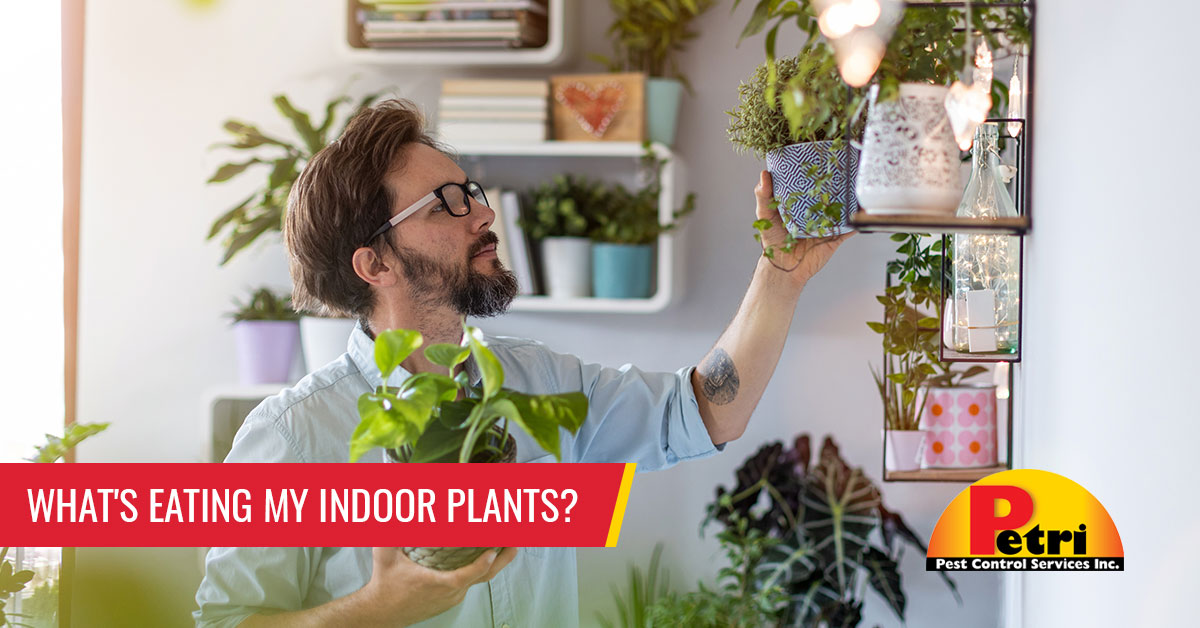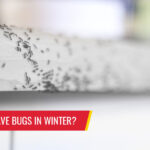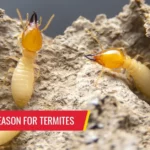
Possibly fueled by a growing demand for green spaces, there’s been a sharp rise in the number of homes that now regularly include indoor plants for decoration, but what happens if your plants struggle despite your best efforts to water and provide the right exposure to sunlight? In short, something might be eating your plants. It’s important to be familiar with the types of common household pests that infest houseplants and what you can do to identify and prevent infestation in your plants and avoid infesting your existing plants when you bring new indoor plants home.
Some of the most common houseplant pests include:
Scale insects
Common brown scales can be tricky to spot as they don’t look like insects. Usually, oval-shaped brown, and about 3-4 mm long and about half as wide. Scales are named for their scale-like appearance with waxy or armored coverings. Often found in clumps along stems, scales suck the juices out of plants via their spiky mouthparts. Eliminating scales is relatively simple as these pests only move when young.
- Prevent scales from falling into your soil by placing a plastic bag or some other covering around the soil of your plant.
- Spray the plant with a natural, rosemary insecticidal soap.
- Brush scales off of the plant with a toothbrush or your fingers.
- Finally, spray the plant with a strong hose in a sink or shower.
- Check your plant for scale every few days.
Spider mites
Because spider mites look like spider webs, these pests can go unnoticed for a while. Spider mites can even look like dust on a spider web but are usually tiny mites spinning tiny webs and placing eggs all over your plant and in the soil. Then, they suck the life out of your plant. A good way to get rid of these pests is to spray your plant down with an organic fungicide, such as Flying Skull Nuke ‘Em Insecticide and Fungicide. If this product doesn’t kill every spider mite in 24 hours, you may need to spray again in the next few weeks to make sure spider mites are out of your house.
Mealybugs
Looking like cotton ball puffs, mealybugs are often mistaken for aphids or webbing and are found in the cruxes where leaves meet branches. In reality, mealybugs are soft-bodied insects that also suck the life out of plants. Fortunately, they’re easier to control than spider mites.
- Just dab each one with an alcohol-dipped Q-tip to eliminate adult mealybugs.
- Spray down your plant with insecticidal soap to get rid of the smaller mealybugs.
- Because insecticidal soap won’t kill the eggs, treat your plant again in a week or so to eliminate hatchlings.
Additionally, releasing beneficial insects, including the green lacewing and the aptly named, mealybug destroyer, work well to get rid of infestations. Also, eliminate any ants on your plants as ants have been known to lift and carry mealybugs into your home so they can feast on the honeydew mealybugs excrete.
Speaking of honeydew – Aphids
While aphids are more commonly a problem for agricultural plants and roses, sometimes these soft-bodied pests can be found on indoor plants, as well. While they’re easy to physically remove with your fingers, you can usually eliminate them by taking your plant outside on a sunny morning and spraying it with a hose. If aphids persist on your plants, consider releasing green lacewings or ladybug larvae.
Whiteflies
A common pest to South Florida ornamentals, whiteflies can go unnoticed while they suck the nutrients out of your plants, on the underside of leaves. However, if you consciously check your plant for whiteflies, they’re easy to spot because they will fly into the air when disturbed. Whiteflies can damage and even kill plants so it’s best to be on the lookout for these pests. Hosing your plants with short blasts of water from your garden hose will dislodge whiteflies from your plants. You can set out yellow sticky traps, as whiteflies are attracted to the color yellow, or you can release green lacewing, ladybird beetle, or whitefly parasites to rid your houseplants of whiteflies. If you are dealing with whiteflies we offer a whitefly treatment to get rid of these annoying pests!
Fungus gnats
More of a problem for plant owners than the plants themselves, fungus gnats are annoying in the same way fruit flies can be problematic. Usually a result of over-watering, fungus gnats breed in the soil and you can eliminate these pests merely by allowing the soil in your plants to dry out, then sprinkling the soil with rice hulls.
Thrips
Less common to houseplants, thrips are elongated insects that can wreak havoc on plants, spreading rapidly to infest your other plants, puncturing the outer layer of plants, and causing a silver discoloration on leaves. Releasing natural predators, thrips predators and minute pirate bugs in tandem works to get rid of these destructive pests, as does placing blue sticky traps around your plant as thrips are attracted to the color blue.
Common Issues with Houseplants
For some people, caring for houseplants is second nature but for others, it takes effort and time. Over the years, we have found that the most common issues with houseplants are a result of overwatering and poor plant nutrient levels.
- Overwatering
Along with pesky insects, one of the most common issues that can affect the health of your houseplants is overwatering and poor drainage. Yellowing leaves can mean your plants are suffering from root rot because the roots are sitting in water. Knowing when each plant needs water can take a little while to figure out but is essential for the health of your houseplants. Underwatering can affect your plants’ health but is easier to detect (i.e., when plants start to droop) and correct.
- Plant Nutrients
After eliminating mealybugs and any other plant pests, feed your plant nutrients, as most plant problems occur when plants are stressed and vulnerable to attack, apart from ants staging picnics at the expense of your houseplants.
Preventing Houseplant Pests
As anyone who has experienced houseplant pest infestations can tell you, preventing a pest situation is a whole lot easier than controlling one.
- Before you purchase houseplants or bring them into your home, inspect them for insects or pests.
- When you bring plants indoors from your patio, deck, or porch, check the soil in containers for insects that could cause problems. Better yet, use sanitized containers and fresh soil. Most insects that live in the soil don’t attack houseplants, except for millipedes, who may eat bulbs and tubers. One or two millipedes aren’t a problem but if your soil is teeming with them, you can manually pick them off of your plant or spread diatomaceous earth on the soil, which should help. You can also employ nematodes that over time will multiply inside millipedes, eventually killing them.
- When you bring houseplants into your abode, much like quarantining, you should keep new plants away from your other plants as much as possible for a few weeks. If your new plants are harboring pests, they won’t be able to spread to all of your plants.
- Keep your home’s outdoor areas pest-free with regular pest control services to prevent bringing pests into your home unknowingly. Although you may not realize it, you could easily brush up against a tree or bush and bring in an uninvited mealybug or spider mite infestation on your clothes or hands. Petri Pest Control Services offers a thorough lawn and shrub treatment program that could prevent this from happening by keeping the exterior of your home in check.
Petri Pest Control Services, locally owned and family operated for over sixty years, offers the full spectrum of pest control services to homeowners in Broward and Palm Beach Counties. Specializing in perimeter treatments, where infestations begin, Petri Pest Control’s certified technicians strategically place materials and baits to prevent pests from entering your home. Contact us for a free pest inspection!
What’s Eating My Indoor Plants in Pompano Beach How To Identify And Control Houseplant Pests?
Pest Control in Pompano Beach and Boynton Beach


